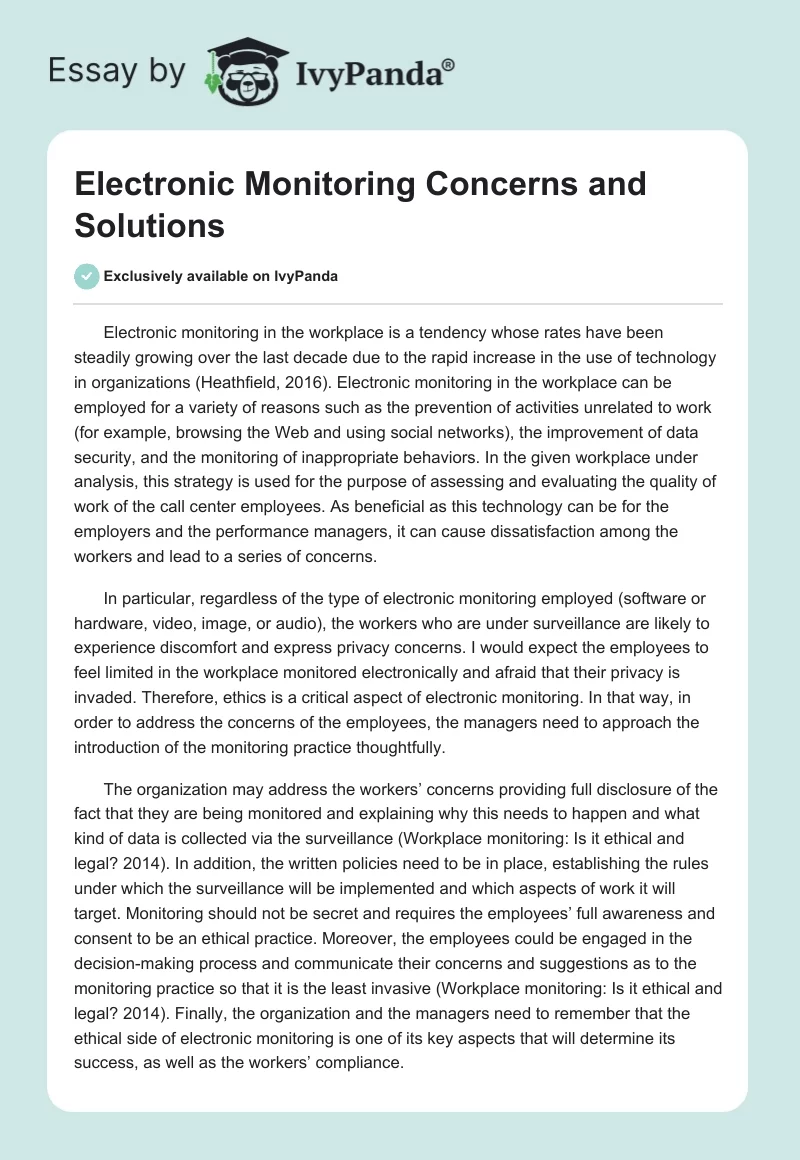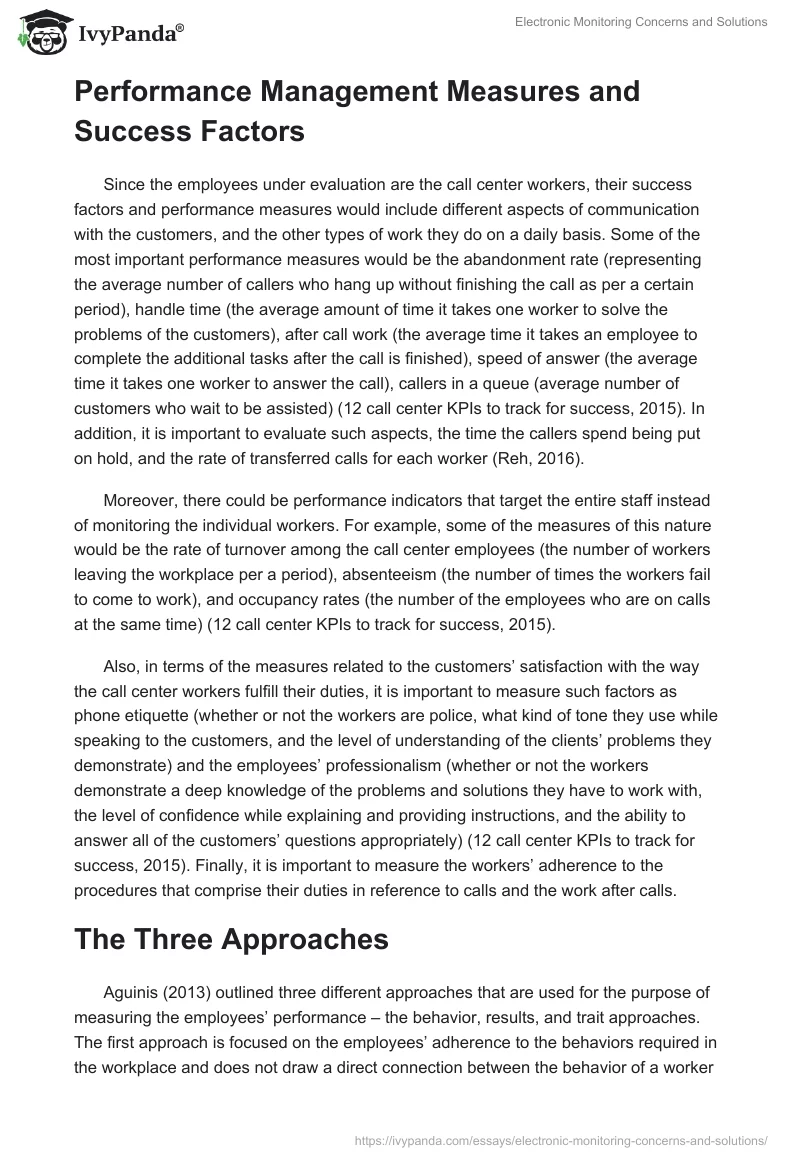Electronic monitoring in the workplace is a tendency whose rates have been steadily growing over the last decade due to the rapid increase in the use of technology in organizations (Heathfield, 2016). Electronic monitoring in the workplace can be employed for a variety of reasons such as the prevention of activities unrelated to work (for example, browsing the Web and using social networks), the improvement of data security, and the monitoring of inappropriate behaviors. In the given workplace under analysis, this strategy is used for the purpose of assessing and evaluating the quality of work of the call center employees. As beneficial as this technology can be for the employers and the performance managers, it can cause dissatisfaction among the workers and lead to a series of concerns.
In particular, regardless of the type of electronic monitoring employed (software or hardware, video, image, or audio), the workers who are under surveillance are likely to experience discomfort and express privacy concerns. I would expect the employees to feel limited in the workplace monitored electronically and afraid that their privacy is invaded. Therefore, ethics is a critical aspect of electronic monitoring. In that way, in order to address the concerns of the employees, the managers need to approach the introduction of the monitoring practice thoughtfully.
The organization may address the workers’ concerns providing full disclosure of the fact that they are being monitored and explaining why this needs to happen and what kind of data is collected via the surveillance (Workplace monitoring: Is it ethical and legal? 2014). In addition, the written policies need to be in place, establishing the rules under which the surveillance will be implemented and which aspects of work it will target. Monitoring should not be secret and requires the employees’ full awareness and consent to be an ethical practice. Moreover, the employees could be engaged in the decision-making process and communicate their concerns and suggestions as to the monitoring practice so that it is the least invasive (Workplace monitoring: Is it ethical and legal? 2014). Finally, the organization and the managers need to remember that the ethical side of electronic monitoring is one of its key aspects that will determine its success, as well as the workers’ compliance.
Performance Management Measures and Success Factors
Since the employees under evaluation are the call center workers, their success factors and performance measures would include different aspects of communication with the customers, and the other types of work they do on a daily basis. Some of the most important performance measures would be the abandonment rate (representing the average number of callers who hang up without finishing the call as per a certain period), handle time (the average amount of time it takes one worker to solve the problems of the customers), after call work (the average time it takes an employee to complete the additional tasks after the call is finished), speed of answer (the average time it takes one worker to answer the call), callers in a queue (average number of customers who wait to be assisted) (12 call center KPIs to track for success, 2015). In addition, it is important to evaluate such aspects, the time the callers spend being put on hold, and the rate of transferred calls for each worker (Reh, 2016).
Moreover, there could be performance indicators that target the entire staff instead of monitoring the individual workers. For example, some of the measures of this nature would be the rate of turnover among the call center employees (the number of workers leaving the workplace per a period), absenteeism (the number of times the workers fail to come to work), and occupancy rates (the number of the employees who are on calls at the same time) (12 call center KPIs to track for success, 2015).
Also, in terms of the measures related to the customers’ satisfaction with the way the call center workers fulfill their duties, it is important to measure such factors as phone etiquette (whether or not the workers are police, what kind of tone they use while speaking to the customers, and the level of understanding of the clients’ problems they demonstrate) and the employees’ professionalism (whether or not the workers demonstrate a deep knowledge of the problems and solutions they have to work with, the level of confidence while explaining and providing instructions, and the ability to answer all of the customers’ questions appropriately) (12 call center KPIs to track for success, 2015). Finally, it is important to measure the workers’ adherence to the procedures that comprise their duties in reference to calls and the work after calls.
The Three Approaches
Aguinis (2013) outlined three different approaches that are used for the purpose of measuring the employees’ performance – the behavior, results, and trait approaches. The first approach is focused on the employees’ adherence to the behaviors required in the workplace and does not draw a direct connection between the behavior of a worker and the end result (Aguinis, 2013). In contrast with the behavior approach, the results approach concentrates on the outcomes produced by the workers without regulating the kinds of behaviors that were in place to produce this outcome; it is based on the view that the outcomes and behaviors are tightly connected and that the workers can adjust their behaviors on their own in order to generate the desired results (Aguinis, 2013). Finally, the trait approach represents the type of performance measurement that focuses on the individual characteristics of the employees. This approach dismisses the focal points of the two previous approaches and places a completely different determinant at the top of the performance pyramid. In that way, the personal abilities of the workers are related to the behaviors they demonstrate and the results they produce (Aguinis, 2013).
When it comes to the workplace under discussion (a call center), I believe that the most appropriate one for the measurement of performance is the behavior approach. This choice is based on the idea that underlies this approach – the lack of connection between the behavior and the results. In other words, when the performance of the call center workers is evaluated, it is critical to measure their adherence to the workplace requirements and KPIs such as the speed of answer, the ability to handle problems, knowledgeability, politeness, and phone etiquette and remember that even when all of these indicators show excellent work, the customers may still remain dissatisfied due to a number of external reasons. In fact, this seems to be the case for most professions that involve customer service because there is a large number of circumstances and factors that impact the customers’ satisfaction and the end outcome that cannot be addressed by the employees. The approach I would not use is the trait approach because it is impossible to outline the specific qualities and features of a call center employee who would demonstrate a successful performance.
References
12 call center KPIs to track for success. (2015). Web.
Aguinis, H. (2013). Performance management (3rd ed.). Upper Saddle River, NJ: Pearson Education Inc.
Heathfield, S. M. (2016). Electronic surveillance of employees. Web.
Reh, F. J. (2016). Call center KPI. Web.
Workplace monitoring: Is it ethical and legal? (2014). Web.


